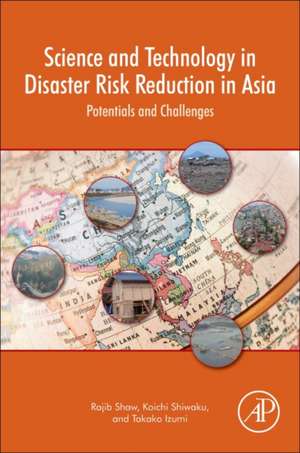Science and Technology in Disaster Risk Reduction in Asia: Potentials and Challenges
Editat de Rajib Shaw, Koichi Shiwaku, Takako Izumien Limba Engleză Paperback – 3 oct 2017
- Covers new research on the role of science in Disaster Risk Reduction and lessons learned when research has been applied
- Utilizes case studies to outline the broader lessons learned
- Focuses on the Sendai Framework, which was adopted in the Third UN World Conference in 2015
Preț: 474.03 lei
Preț vechi: 651.21 lei
-27% Nou
Puncte Express: 711
Preț estimativ în valută:
90.73€ • 98.59$ • 76.27£
90.73€ • 98.59$ • 76.27£
Carte tipărită la comandă
Livrare economică 14-28 aprilie
Preluare comenzi: 021 569.72.76
Specificații
ISBN-13: 9780128127117
ISBN-10: 0128127112
Pagini: 524
Dimensiuni: 152 x 229 x 33 mm
Editura: ELSEVIER SCIENCE
ISBN-10: 0128127112
Pagini: 524
Dimensiuni: 152 x 229 x 33 mm
Editura: ELSEVIER SCIENCE
Public țintă
Professionals in disaster risk reduction across governmental agencies, intergovernmental agencies, NGO, researchers in the field of environment and climate change studiesCuprins
1. Science and Technology in Disaster Risk Reduction: An Analytical Overview
Part 1: Understanding disaster risk
2. Understanding Disaster Risk and Science and Technology
3. Social Background in Char Areas, Bangladesh: Implication for Japanese Hazard Mapping Technology
4. Validation of indigenous knowledge for disaster resilience against river flooding and bank erosion
5. Hazard development chain of climate change induced salinity intrusion in Sundarbans socio-ecological system, Bangladesh
Part 2: Strengthening disaster risk governance to manage disaster risk
6. Disaster Risk Governance and City Resilience in Asia-Pacific region
7. Strengthening disaster risk governance to manage disaster risk: An overview
8. Education Governance and the Role of Science and Technology
9. Utilizing Ecosystem Services for Disaster Risk Reduction: The Role of Scale and Context
10. Building Code Implementation in Nepal: An Experience on Institutionalizing Disaster Risk Reduction in Local Governance System
11. Disaster Risk Governance in Myanmar: problems and constraints
Part 3: Investing in disaster risk reduction for resilience
12. Investing in Disaster risk reduction and implication to utilization of Science and Technology
13. Role of Small and Medium Scale Enterprises in Urban Resilience of Mumbai
14 Constraints in institutional investment on DRR in India
15 Post Disaster Needs Assessment for Resilient Recovery using Innovative Tools, Techniques and Space Applications
16. Community-based Responses to Flood and River Erosion Hazards in the Active Ganges Floodplain of Bangladesh
Part 4: Enhancing disaster preparedness for effective response and to "Build Back Better" in recovery, rehabilitation and reconstruction
17. Recovery process and Science and Technology: an Overview
18. Capacity Development of School Teachers in Disaster Recovery Process
19. Role of Social Transformation in Community Recovery from Cyclone Nargis: Case of Kung Thee Chaung Village, Myanmar
20. Built Back Better: Focus on Resilience and Participation-A Case of Sikkim Reconstruction and Rehabilitation
21. Improvement of Responses and Recovery Approaches for Cyclone Hazards in Bangladesh
22. Constraints and coping measures of coastal community towards safe drinking water scarcity in southwestern Bangladesh
Part 1: Understanding disaster risk
2. Understanding Disaster Risk and Science and Technology
3. Social Background in Char Areas, Bangladesh: Implication for Japanese Hazard Mapping Technology
4. Validation of indigenous knowledge for disaster resilience against river flooding and bank erosion
5. Hazard development chain of climate change induced salinity intrusion in Sundarbans socio-ecological system, Bangladesh
Part 2: Strengthening disaster risk governance to manage disaster risk
6. Disaster Risk Governance and City Resilience in Asia-Pacific region
7. Strengthening disaster risk governance to manage disaster risk: An overview
8. Education Governance and the Role of Science and Technology
9. Utilizing Ecosystem Services for Disaster Risk Reduction: The Role of Scale and Context
10. Building Code Implementation in Nepal: An Experience on Institutionalizing Disaster Risk Reduction in Local Governance System
11. Disaster Risk Governance in Myanmar: problems and constraints
Part 3: Investing in disaster risk reduction for resilience
12. Investing in Disaster risk reduction and implication to utilization of Science and Technology
13. Role of Small and Medium Scale Enterprises in Urban Resilience of Mumbai
14 Constraints in institutional investment on DRR in India
15 Post Disaster Needs Assessment for Resilient Recovery using Innovative Tools, Techniques and Space Applications
16. Community-based Responses to Flood and River Erosion Hazards in the Active Ganges Floodplain of Bangladesh
Part 4: Enhancing disaster preparedness for effective response and to "Build Back Better" in recovery, rehabilitation and reconstruction
17. Recovery process and Science and Technology: an Overview
18. Capacity Development of School Teachers in Disaster Recovery Process
19. Role of Social Transformation in Community Recovery from Cyclone Nargis: Case of Kung Thee Chaung Village, Myanmar
20. Built Back Better: Focus on Resilience and Participation-A Case of Sikkim Reconstruction and Rehabilitation
21. Improvement of Responses and Recovery Approaches for Cyclone Hazards in Bangladesh
22. Constraints and coping measures of coastal community towards safe drinking water scarcity in southwestern Bangladesh
